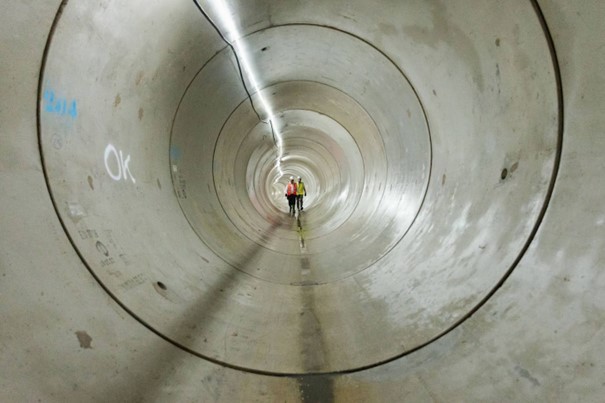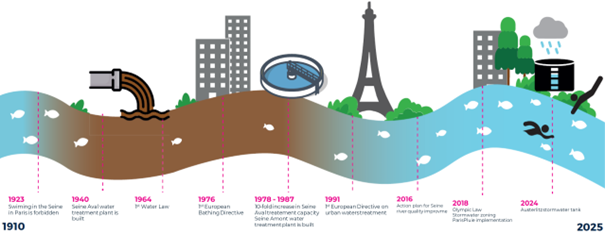Swimming in the Seine is a practice that has existed for centuries. From the 17th century, special facilities were built to prevent disturbances around swimming [1]. Changing rooms were constructed, and swimming areas were enclosed [1]. Over the centuries, these facilities became increasingly refined. Additionally, more swimming pools emerged, fed by the Seine but with heavily purified water [1]. Swimming competitions were already held in the Seine during the 1900 Olympic Games. However, in the early 20th century, water quality significantly declined [1]. Since 1923, swimming in the river has been prohibited to protect swimmers from strong currents, water traffic, and especially pollution. By this time, the river had become saturated with pollution due to sewage systems discharging into it [2]. The first major sewage treatment plant was built in 1938, but it wasn’t until after World War II that sewage was effectively treated [2]. Nevertheless, sporadic swimming in the river still occurred during this time, especially between the 1930s and 1950s [1]. The Water Law of 1964 provided financial resources to improve sewage treatment and infrastructure [2]. In the decades that followed, swimming in the Seine remained a dream. However, momentum seemed to pick up again from the 2010s onwards. In 2012, a lobbying group was established to make the water swimmable again, and swimming competitions resumed in the river from 2015 onwards. The 2024 Paris Olympics served as a catalyst for further river cleaning to enable swimming competitions. Additionally, three locations (see Image 1) have been selected for swimming starting from 2025 [3].

Introduction:
The Seine, a central artery in the French landscape and economy, flows through the heart of Paris and is an essential part of national water management. This detailed examination focuses on the physical characteristics, water quality, maintenance, connections, climate impact, and urban relations of this famous river.
Physical Characteristics:
Current Water Quality:
Maintenance and Management:
Connected Waterways:
Impact of Climate Change:
Bank Protection:
Water Traffic:
Conclusion:
References:
Due to Paris having a combined sewer system, there are many sewage overflows during heavy rainfall, leading to strong pollution of the Seine (in addition to chemical waste from industry). To counteract this, the storage capacity of the system must be increased to prevent sewage overflow (containing dangerous bacteria) during excessive rainfall [4].
For this reason, the city has initiated a €1.4 billion project aimed at the large-scale revision of infrastructure by installing new pipes, storage facilities, and pumps [4]. For example, a storage facility is being constructed near Austerlitz metro station capable of holding as much water as 20 swimming pools (50,000 m3) [4], see Images 2 and 3. Since March 26, 2018, moored boats are no longer allowed to dump their waste into the river but must be connected to the sewer [5]. Additionally, purification processes have been optimized and intensified at the sewage treatment plants along the Seine and Marne (a tributary of the Seine) [5].
So, the Seine itself is not actually being cleaned, but efforts are made to prevent it from being polluted by the city’s sewage and boats, and by purifying water before it enters the river. In the summer of 2022, 91% of test locations were deemed swimmable according to daily measurements (July 20 to August 11) [5]. In early June 2023, “excellent results” were again measured according to European guidelines. However, in August, several events had to be canceled due to pollution after heavy rainfall [5]. This once again demonstrated a strong correlation between water quality and weather. During heavy rainfall, the river becomes heavily polluted.
In response to this, an additional plan has been devised consisting of 3 parts [5]:
Strengthen monitoring of sewage systems in Paris and upstream (overflow, discharges from factories, etc.).
Place all other forms of pollution under enhanced supervision (boats).
Establish a system to identify and address any pollution.


In the image below, a timeline is depicted showing the key moments that have led to the project currently in development. The ultimate goal is to make the Seine swimmable by 2025.

Another significant moment was the electoral promise of former French President Jacques Chirac. In 1988, during the elections, he promised to make the Seine swimmable again [1]. This is still seen as an empty campaign promise because he achieved little.
In the years that followed, little progress was made in making the Seine swimmable again. From the 2010s onwards, the idea gained momentum again with the establishment of a collective. The Laboratoire des baignades
urbaines expérimentales (LBUE) promotes swimming in the river and canals in Île-de-France [1]. They also take action for this, for example, in 2016, with more than 100 residents jumping into the river without permission. This is not allowed [1]. Since 2015, open water races have also been organized again. Initially by Paris Swim, but later also by the French Swimming Federation (FFN) [1]. This has led to two significant changes in awareness among the Parisian population. Firstly, it provides a greater historical awareness and cultural heritage that people have been swimming in the river and canals for centuries. This also ensures the preservation of this heritage for future generations. Secondly, it also enhances the quality of life of Parisians. Improving water quality creates a more attractive and healthier urban environment.
The main driving force remains the organization of the Olympic Games in Paris in 2024. To promote the city, there was the idea of holding the competitions in the Seine again. This was also the case during the 1900 Games [1]. Additionally, it is of course the ideal to be able to swim in the river with the Eiffel Tower in the background. This can give a huge boost to tourism.
The main initiative to clean the river on a large scale is the organization of the Olympic and Paralympic Games in 2024. Collaborations have been established between government agencies (both local and national), sports organizations, and environmental organizations.
Despite the significant improvement in the sewage system, the water quality of the Seine still heavily depends on the weather. After heavy rain showers, swimming is not possible [5]. So, polluted water still ends up in the river via overflows. The capacity will need to be further increased.
There are various authorities responsible for the water quality of the Seine at different levels:
Agence de l’eau Seine-Normandie (AESN): The agency responsible for the entire Seine and Normandy watershed. It mainly supervises the water quality of the watershed through a watershed committee and manages finances. They are also responsible for developing a master plan for climate change.
Prefecture of the Île-de-France region: Local government agency that translates national policies on water quality and the environment into local policies in Île-de-France. This roughly corresponds to the Paris region.
Agence régional de santé (ARS): France’s health agency. Since this agency focuses on public health, it also oversees water quality for safe human use and recreation.
Municipal authorities: All municipalities bordering the Seine in this area share responsibility for water quality. Mainly concerning sewage. This means they also have a lot of influence on the river’s water quality.
Ministère de la transition écologique et solidaire: This ministry is responsible for national environmental policy, including water quality and management.

[1] Se baigner à nouveau dans la Seine : l’héritage promis par par les Jeux olympiques et paralympiques de Paris 2024, Julia Moutiez, Projects de paysage, 2021.
[2] A return to swimming in the Seine, Sarbonne Université www.sarbonne-universite.fr, 13-07-2023
[3] Baignade dans la Seine : les trois sites où il sera possible de nager à Paris, ActuParis, www.actu.fr, 10-07-2023.
[4] For the first time in a century, Paris is making the Seine swimmable, Smithsonian Magazine www.smithsonianmag.com, 17-05-2023.
[5] Dès 2025, la Seine va s’ouvrir à la baignade, Ville de Paris www.paris.fr, 11-12-2023.
[6]
Stay up to date about Swimmable Rivers, sign up for our newsletter.
Adress
Korte Ouderkerkerdijk 7
1096 GB Amsterdam
The Netherlands